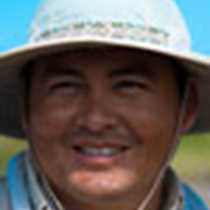Isabela Island
The enchanted islands surprised us one more time! Today a dream came true while we were visiting one of the most conspicuous islands in the Galápagos Archipelago. Isabela Island is the largest island of the Galápagos with an area of 4,640 square kilometers (1,790 sq. miles). Giant tortoises, land iguanas, penguins, flightless cormorants, sea lions and whales made this day unforgettable.
Our remarkable morning outing took place in Urvina Bay. This calm bay with crystal clear water housed several sea turtles that gave us a cordial welcome to the island. The bizarre black sand beach, which is a main nesting site for sea turtles and the top predator of the Galapagos Islands: the Galapagos hawks. The Galapagos hawks were on every square inch of the beach and delighted our guests with their curiosity. Once we all were ready, we took the path that led us to the interior of this unique and fabulous place. Our voyagers sighted giant prehistoric creatures that were exploring new grounds on the flanks of Alcedo volcano. The enjoyment in their faces was unforgettable when the giant tortoises surprised us. This unique experience continued into the dense vegetation where colorful land iguanas were found. After a long walk, with the delightful melodies of the Darwin finches, mockingbirds and warblers, we reached the coastline of Urvina that once was underwater. Big heads of corals and other marine organisms were exposed due to a sudden volcanic uplift that took place in 1954. The two and a half mile walk was well worth it.
The afternoon couldn’t be better. The cozy bay known as Tagus Cove, that once was the refugee for pirates and buccaneers, was our next destination. While many of us were snorkeling, others were exploring the wonders of Isabela Island from kayaks and zodiacs. The bizarre tuff landscape provides shelter for different species of sea birds such as blue-footed boobies, brown noddies and pelicans. The marine kingdom offered us different kinds of fishes typical for these nutrient-rich waters. Sea turtles, rays, penguins and even sea lions formed a mosaic of species during our outing.
Late in the afternoon we took a walk on the rim of a parasitic tuff cone where we observed the impressive Darwin’s Lake; several species of land birds such as finches, mockingbirds, and warblers enchanted all of us while we were having a moment of silence at the highest point of the path. Mother Nature was appreciated from different perspectives and our mystical day ended when the silence of the bay was interrupted by the spout of blue whales.




